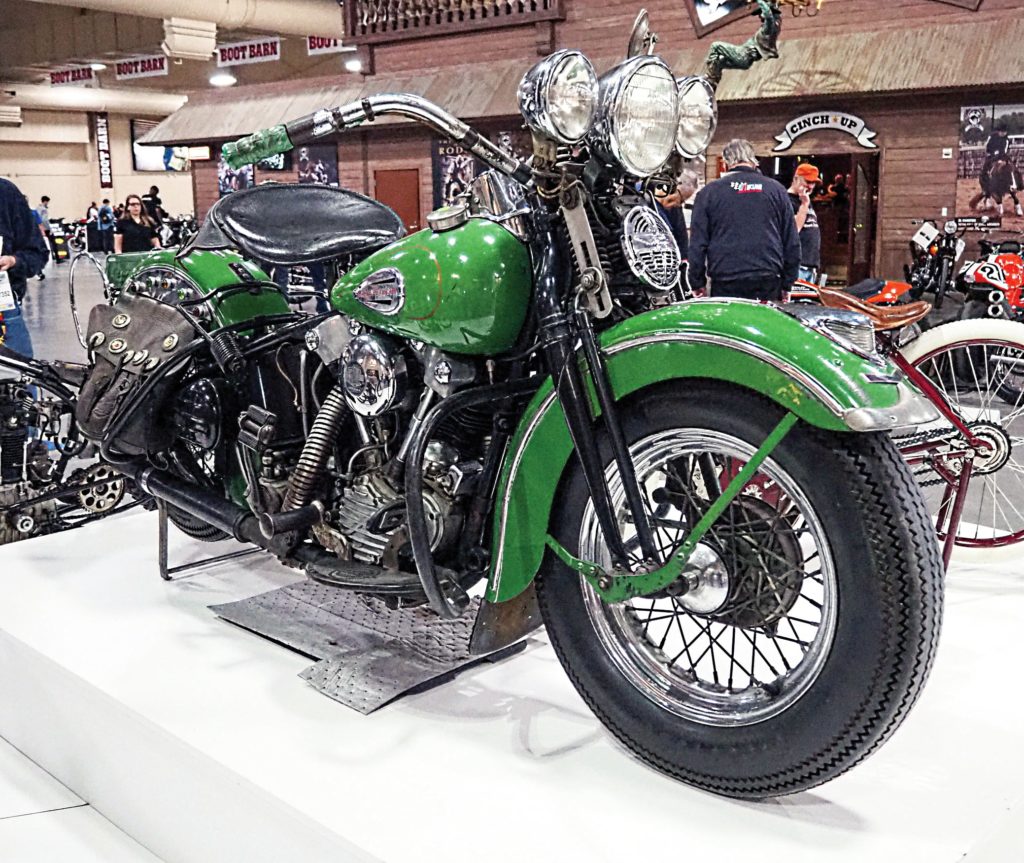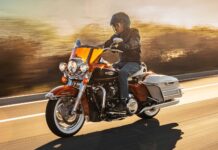Todd Bertrand, a customer of mine in the olden days at California Harley, recently put his 1940 EL Knucklehead up for auction at the Mecum Auction in Las Vegas. It hammered for an eye-watering $220,000! And to an investor, not a rider. Why?
As the story goes, it is an original-paint custom-order bike that left the factory in a green color that hadn’t been sprayed on a stock hog since 1938. It also featured some nickel-plated shiny bits instead of chrome ones, as per 1940 standard fare. The point is, this was all factory original, not a custom treatment after the fact. ‘Greenie,’ as it has come to be called, is historic because it ‘proves’ that H-D did such things long before we ever suspected! Not in the brochure, but in a sort of Custom Vehicle Operation way that occurred decades before the CVO program we have today.
Back in 2014, Greenie came up for auction at Bonhams and sold for a record price – to Bertrand. He then spent six years researching and documenting what he had. You can follow his story on YouTube. (Search Hunting Harleys # Greenie for details.) The story is plausible, but mostly circumstantial.
The notoriety of a green – but otherwise unremarkable – 1940 Knucklehead rests on the fact that it was a factory piece. Right off, I wondered which dealer ordered it, and for what customer? Since it didn’t resurface for thirty years after it was built, that seems mysterious. Could it be it was never shipped to a dealer? Or never built for a specific customer, but by one? In other words, are there alternative explanations for how Greenie came to be? I think so. Indulge me as I cover some of my hopefully equally plausible theories about how these unique machines come to be.

I know the history of my 1985 Harley (VIN-code EKL) FXRP well. It was one of 161 specially built machines, ordered by the California Highway Patrol, shipped to Harbor City Harley-Davidson, un-crated, prepped and delivered. In 1989, with a little over 22,000 miles, it was ‘retired’ and sold at CHP auction to my brother, who rode it for about 18 months and sold it to me. I’ve had it since. The dealer never ordered it for showroom inventory; they were just the middleman. The customer – CHP – specified the non-standard features, including paint, making this a verifiable example of how bikes like Greenie can come into existence yet stay off the ‘brochure/catalog’ radar.
A well-documented benefit to workers in the American watch industry is that employees could, on their own time, build their own watch – unique time pieces made with extra jewels, better finishing, custom dials and more. These come onto the market from time to time, all with serial numbers, and most are simply listed in factory records as ‘special.’ But few, if any, would have gone to or through a retail jeweler. So we have non-standard watches, never ordered by a regular customer and not built by the factory, but by a factory worker. A lot of factories in a lot of industries did this sort of thing during the depression, perhaps even H-D.
Triumph Motorcycles Of America, in the late ’70s, was the U.S. branch of the so-called worker’s co-op that built the last Meridan Bonnevilles. Warranty returns from U.S. dealers came to our facility but were not sent back to England. These parts were useless junk economically, but functionally quite useful much of the time. Let’s just say if you worked at TMA you could keep your Bonnie 750 running pretty easily and dirt cheap, too. You could even, patiently and over time, build a complete motorcycle. All you needed was a trip to the DMV with receipts and a good story to get a builder’s title. Once more, an alternative to traditional factory construction.
Lastly, as a possible explanation for Greenie’s odd ‘factory’ paint job, there’s what I’d call the ‘Shelby method.’ Legend holds that ol’ Shel was hustling the magazines with his demonstrator Cobras, hoping for – and getting – some incredibly helpful ink on his awesome creation. Later it was revealed all these Cobras were actually one car! (VIN #CSX2000) He’d get it back from one magazine, repaint it, trick it up a little differently and send it back out to another. In the film Ford vs. Ferrari there’s a scene in which he does much the same thing with customers for the car. Shel’s version of the old shell game. It worked. Who knows if H-D had a precious few demonstrators for the new and improved knuckleheads with, shall we say, ‘special details and colors’ to get the point across to dealers of the day?
If you have any tech tips
or questions or unsolvable
motorcycle mysteries, email
motorhead@thunderpress.net.



















